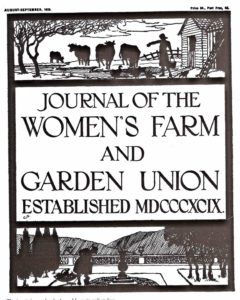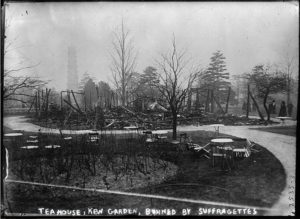To make the centenary of certain women being given the vote I have been thinking about the place of the garden or public park in the suffragette diet action campaigning of the early 20th century. Here is an extract from my 2011 book Radical Gardening.
 In the later nineteenth and early decades of the twentieth century, though, some of these gendered gardening practices combined with and contributed to the growing demand for female suffrage and women’s rights. Suffragettes were gardeners, suffragettes targeted gardens for attack—in each instance horticulture was politically positioned. What is today called the Women’s Farm and Garden Association was established originally in London in 1899 as the Women’s Agricultural and Horticultural International Union. Its founders were characterised by their privileged backgrounds and their belief in universal suffrage—and their energy was charged with the power of the key campaign of the period. In a 1900 paper to the Women’s Institute in London, one, a Mrs Chamberlain, articulated her view of the development of social activism which was a decidedly non-grassroots perspective:
In the later nineteenth and early decades of the twentieth century, though, some of these gendered gardening practices combined with and contributed to the growing demand for female suffrage and women’s rights. Suffragettes were gardeners, suffragettes targeted gardens for attack—in each instance horticulture was politically positioned. What is today called the Women’s Farm and Garden Association was established originally in London in 1899 as the Women’s Agricultural and Horticultural International Union. Its founders were characterised by their privileged backgrounds and their belief in universal suffrage—and their energy was charged with the power of the key campaign of the period. In a 1900 paper to the Women’s Institute in London, one, a Mrs Chamberlain, articulated her view of the development of social activism which was a decidedly non-grassroots perspective:
Social movements spread from the top downwards. If, presently, girls and women of the less educated classes find that a country life, and work on farm or garden, is not without charm for the more educated classes, they will not be so anxious to get away to towns and shops…. When it is seen that ladies are healthy, happy and contented working on the land, the rustic damsel will begin to think it may be worthwhile to acquire knowledge of the primitive industries they have so neglected.
‘Why was it’, asks Peter King in Women Rule the Plot, ‘that women were now encouraged to take to the groves of horticulture rather than the groves of academe? It may have been because the women’s movement generally at this time was anxious to do something practical, rather than theoretical or academic’. In fact the academic side was also part of the target as a number of new horticultural colleges and courses were opening up exclusively for women at this time. Glynde College for Lady Gardeners, Sussex, Studley, Swanley, Kent, the Thatcham Fruit and Flower Farm School, Berkshire, Waterperry, Oxon.—these were among the new institutions offering courses for women in gardening, horticulture, landscape architecture. Jane Brown states the fundamental connection: ‘the first generations of students were often involved in suffragette politics, many were university women’.
The gardening energy and suffragist zeal of Union members were soon channelled into a newly pressing social crisis: World War One and the new roles of women in industry and agriculture to compensate for the absence of men. Following the wartime food crisis of 1916, the Women’s Farm and Garden Union, as it was renamed, was pivotal in the establishment of the Women’s Land Army the following year. The Women’s Land Army was even more active in World War Two, when the new generation of ‘land girls’ were central to the anti-fascist ‘Dig for Victory’ campaign, with their gendered perspective and an emancipatory rhetoric. Their official song exhorted new recruits with the promise:
you’ll think that the country life’s grand; / We’re all needed now / We must speed with the plough / So come with us—back to the land!
As Alison Woodeson comments, for the upper-class women still organising the Women’s Land Army in World War Two (or, like Vita Sackville-West, writing its history), ‘there was no doubt that the country life was indeed “grand”. The enjoyment these affluent ladies took in their own extensive, landscaped gardens was part and parcel of the upper-class perception that the countryside, with its supposedly organic and healthy way of life, was infinitely more desirable than the grimness and artificiality of the industrial cities’. For the land girls themselves, the pastoral reality could be startlingly different.
 Suffragettes could employ gardening in other (radical) ways too. In the face of increasing government dilatoriness and obstruction and harsh treatment of activists at the hands of police and prison authorities, their direct action campaign for the vote was becoming more extreme, and progressed from smashing Prime Minister Herbert Asquith’s windows to fire-bombing his Chancellor, Lloyd George’s, new house. At the same time as the arson attack, in what was reported as an act of ‘female vandalism’ in February 1913 Suffragettes attacked the Orchid House and returned later to burn down the Tea Pavilion at the Royal Botanic Garden at Kew. Was Kew targeted in implicit or explicit acknowledgement of its link with empire, tradition, masculinity? The acts did not simply attack the male establishment, they also signalled a refusal of that ‘link between flowering plant and old-style femininity’ written of by Perényi above, a refusal to be a ‘rare and delicate plant’. Following the attack on the Orchid House, the Journal of Horticulture and Home Farmer reported:
Suffragettes could employ gardening in other (radical) ways too. In the face of increasing government dilatoriness and obstruction and harsh treatment of activists at the hands of police and prison authorities, their direct action campaign for the vote was becoming more extreme, and progressed from smashing Prime Minister Herbert Asquith’s windows to fire-bombing his Chancellor, Lloyd George’s, new house. At the same time as the arson attack, in what was reported as an act of ‘female vandalism’ in February 1913 Suffragettes attacked the Orchid House and returned later to burn down the Tea Pavilion at the Royal Botanic Garden at Kew. Was Kew targeted in implicit or explicit acknowledgement of its link with empire, tradition, masculinity? The acts did not simply attack the male establishment, they also signalled a refusal of that ‘link between flowering plant and old-style femininity’ written of by Perényi above, a refusal to be a ‘rare and delicate plant’. Following the attack on the Orchid House, the Journal of Horticulture and Home Farmer reported:
Kew has been marked out by the suffragettes as one of the scenes of their exploits. They smashed a quantity of glass in the orchid house, and in a manner that one can scarcely accredit to sane adults, wantonly tried to destroy the plants. Rare and delicate plants, under bell-glasses, attracted the special venom of these feminists.
Three greenhouses were smashed and plants uprooted. Suffragettes were also damaging flower-beds up and down the country in what Hoyles calls this ‘most violent clash between women and the gardening establishment’. After the second attack, the Journal’s reporter did not simply discredit the activists’ sanity as above, but declared them ‘insane’: ‘For the second time within a fortnight female vandals have visited Kew Gardens with direful consequences. The picturesque tea pavilion was razed to the ground by fire. Happily the perpetrators were captured and are unlikely to resume their insane campaign for some time to come’. In Jenny Uglow’s veiw, ‘for radical women, gardening could represent everything domineering in the British establishment…. Women, far from delicate, would not be kept under glass any more’….
Why would women’s rights activists, suffragists and suffragettes, look to the garden as a zone of contestation? On the one hand, gardening and farming more generally had been either male-dominated areas or ones in which the female contribution was downgraded, menial (‘weeding women’), and so by its nature a worthy area for a challenge to the expectations and limitations of gender. As the profusion of new gardening books for women shows, the garden was an increasingly significant aspect of middle-class identity through the nineteenth century, especially in the female-oriented domestic sphere. It connected with opportunities in education and new social movements.
On the other hand, the gentle or fragile flower model of femininity was one which activists attacked, and here the garden was understood as standing symbolically for that model, but also for male property, the establishment, even empire—all of which were worthy of attack by militant feminists. Radical gardening in this extraordinary period of the early twentieth century when revolution, workers’ and women’s rights, the crisis of war, and, in Britain, the beginnings of the collapse of imperial consensus, could make possible education in women-only horticultural colleges, or a new career path in garden design, for example, but it could make happen the destruction of existing gardens and public garden spaces by small groups of activists. Hoyles points to the link:
The attack on Kew Gardens is one of the most famous incidents for women’s suffrage. It illustrates the political nature of gardening and its symbolic meaning, just like the example of Kew’s role in the British Empire. Destroying flowerbeds and greenhouses seems insane, unless the gardens and the destruction of them by ‘female vandals’ are seen in terms of the power relations in society. Just as the orchid can symbolise extreme wealth, so a flower-bed can express the power of patriarchy in the political order.
